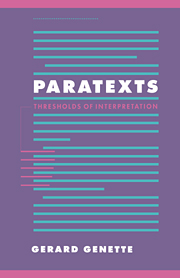Book contents
- Frontmatter
- Contents
- Foreword
- List of books by Gérard Genette
- Translator's note
- 1 Introduction
- 2 The publisher's peritext
- 3 The name of the author
- 4 Titles
- 5 The please-insert
- 6 Dedications and inscriptions
- 7 Epigraphs
- 8 The prefatorial situation of communication
- 9 The functions of the original preface
- 10 Other prefaces, other functions
- 11 Intertitles
- 12 Notes
- 13 The public epitext
- 14 The private epitext
- 15 Conclusion
- Additional references
- Index
5 - The please-insert
Published online by Cambridge University Press: 04 November 2009
- Frontmatter
- Contents
- Foreword
- List of books by Gérard Genette
- Translator's note
- 1 Introduction
- 2 The publisher's peritext
- 3 The name of the author
- 4 Titles
- 5 The please-insert
- 6 Dedications and inscriptions
- 7 Epigraphs
- 8 The prefatorial situation of communication
- 9 The functions of the original preface
- 10 Other prefaces, other functions
- 11 Intertitles
- 12 Notes
- 13 The public epitext
- 14 The private epitext
- 15 Conclusion
- Additional references
- Index
Summary
The four stages
The please-insert [le prière d'insérer] is definitely, at least in France, one of the most typical elements of the modern paratext. It is also one of the most difficult to consider in historical detail, for in some stages of its evolution it takes a particularly fragile form; thus, to my knowledge, no public collection has been able to accumulate these PIs for purposes of research. The classic definition of the please-insert – the one given, for example, in the Petit Robert dictionary – is narrow and describes only one of its stages, the one that was typical in the first half of the twentieth century: “A printed insert that contains information about a work and is attached to the copies addressed to critics.” Current usage extends the meaning of the word to cover forms that no longer fit that definition inasmuch as they no longer consist of an “insert” and are no longer addressed only to “critics.” I will extend the meaning still further by applying the term to other forms, older ones, which perhaps did not yet consist of the insert. But what remains constant in all these various stages, it seems to me, is the definition's functional part (rather vague, to be sure): “printed … contains information about a work.” In other words (in my words), the please-insert is a short text (generally between a half page and a full page) describing, by means of a summary or in some other way, and most often in a value-enhancing manner, the work to which it refers – and to which, for a good half-century, it has been joined in one way or another.
- Type
- Chapter
- Information
- ParatextsThresholds of Interpretation, pp. 104 - 116Publisher: Cambridge University PressPrint publication year: 1997



